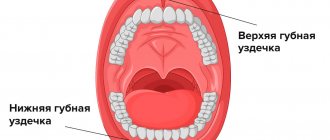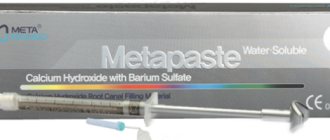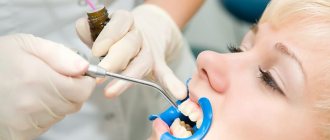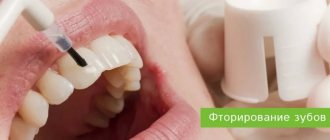Procedures for fixing crowns at the Hollywood clinic
Restore chewing function to your teeth and restore aesthetics to your smile.
A crown is a permanent prosthesis. It restores the aesthetic and chewing function of the tooth. The service life depends on the type of crowns, but, as a rule, it is at least 10 years. For the fixation procedure to be successful, you need to entrust it to a professional. The Hollywood Clinic guarantees the quality of dental services.
When to place crowns
Crowns are installed in the following cases:
- most of the tooth is destroyed by caries or due to trauma,
- the crown part of the tooth is destroyed, but the root is preserved,
- pathological abrasion of enamel,
- teeth look unsightly due to changes in the color of the enamel or tooth shape.
In modern dental practice, ceramic and metal-ceramic crowns are mainly used. The first ones look very natural and visually cannot be distinguished from real teeth. Aesthetics and durability have a corresponding price. As for metal-ceramic crowns, they are most often installed on chewing teeth. The crown is a metal frame lined with ceramics. It looks very natural and is durable. The only thing is that when the gums are lifted, the metal becomes visible.
Gold crowns, popular in the Soviet and early post-Soviet years, are not so in demand today due to their colors. Although, in terms of its performance characteristics, gold is ideal for microprosthetics.
Crown fixation procedure
The procedure for fixing crowns includes several stages. At the first appointment, the dentist examines the oral cavity and draws up a plan for tooth restoration. If necessary, treatment is carried out. The doctor then prepares the tooth for a crown. Using the tool, it is given a shape - the basis for the future prosthesis.
The next step is to take an impression of the oral cavity. The dentist uses a special paste that allows you to make an impression of the teeth. Based on the impression, a crown is created in the laboratory. This takes several days/weeks. While waiting for the impression, the ground tooth is covered with a temporary plastic crown. This is necessary to protect it from caries and other negative factors.
The crown is fixed with cement. Sometimes it is practiced to use a temporary solution. It allows you to wear the crown for several days and evaluate how functional it is and how it fits in shape/size. Then the temporary solution is replaced with a permanent one. In the future, if it is necessary to remove the crown, it can only be sawed. Therefore, as a precaution, temporary cement is used.
Crown care
Caring for a crown is no different from caring for other teeth. Dentists at the Hollywood Clinic recommend using dental floss and performing hygiene procedures using toothpaste and a brush several times a day. For preventive purposes, it is recommended to visit a doctor twice a year.
The Hollywood Aesthetic Medicine Clinic provides a wide range of dental services. We use consumables from the brands Kerr, Estelite, Filtec. Together with Italian Castellini equipment and the experience of doctors, this allows us to achieve excellent results. The fixation of the crowns will be performed flawlessly. Call to make an appointment. You will review your dentist's diplomas and certificates in the office.
What to do if the crown falls off a tooth?
The development of secondary caries, consumption of sticky and hard foods, incompatibility of artificial products with dental tissues, accidental damage are the reasons why installed crowns fall out. What to do in such a situation? Rinse thoroughly, dry and place the prosthesis in a safe and cool place. Then contact a prosthetist for re-fixation, or to make a new structure. If this possibility is not expected in the near future, there are several ways to solve the problem yourself. Temporary fixation of dental crowns will help preserve the integrity of the tissues of the supporting teeth, maintaining their functionality and appearance.
How to use this substance?
The normal temperature at which good mixing will occur is 22-24 degrees Celsius, and the humidity should be around 40-60 percent. If the temperature is higher than normal, then the place where mixing will take place must be cooled, for example, immersed in cold water or left in the refrigerator for several minutes.
The process itself should be gradual. First, all the liquid is mixed with half of the desired solution, and a little is added each time until a homogeneous mass appears. The time it will take to cook is 1 minute.
Temporary fixation technology
At the preparatory stage, the surgical field and orthopedic structures that are to be fixed are dried and isolated from saliva. Degreasing of working surfaces is not required. Temporary cement is mixed taking into account the manufacturer's recommendations. In the future, the fixation technique - using the example of temporary acrylic crowns on eugenol-free cement - looks like this.
- Temporary cement is applied with a spatula to the cervical part of the temporary crown.
- Under bite control in habitual or central occlusion, the orthopedic structure is fixed in the oral cavity.
- After the time specified by the manufacturer, the temporary cement is removed.
- If work is carried out in support of a dental implant, a rubber dam is used to protect the latter.
- The final stage is x-ray control to check the effectiveness of cement removal.
- Fixation is completed by control of occlusal contacts.
- The patient receives recommendations on the rules for caring for the structure (they are practically no different from the case of installing fixed structures on permanent cement, with the exception of replacing dental floss with a dental brush).
Photopolymer – light-curing materials
Photopolymer filling is considered the highest quality. Lighting composites represent the latest generation of materials that provide excellent results. They are produced in the form of a paste that hardens under the influence of UV radiation from a special lamp. They are applied in layers (about 2 mm), which makes it possible to form the shape of the tooth as accurately as possible. Other advantages of the material:
- a wide selection of shades - allows you to choose the desired color, which makes the filling invisible to others;
- strength;
- application for restoration of anterior and lateral teeth;
- low toxicity;
- the highest aesthetic properties compared to other materials;
- slight shrinkage.
A photopolymer filling has virtually no disadvantages. If the restoration technology is followed, it will last for many years. The only negative is the higher price when compared with plastic and cement materials. But the expenses are justified, because the patient receives high quality. Today, dental clinics often work with photopolymers.
There's plenty to choose from
The TOP 5 best adhesives and cements that can be used for self-fixation of crowns at home include:
- Corega;
- Protefix;
- Fittydent;
- The president;
- ROCS.
Coreg contains only components that are absolutely safe for health. It is possible to buy it at a regular pharmacy for $2.5. Gives fixation for up to 24 hours. But there is a high risk of being quickly washed off with water and easily dissolved by exposure to food and drinks.
Protefix, at a cost of $4 to $6, reliably fixes the prosthesis for a period of 10 to 12 hours.
- not very convenient to dose;
- small amount of content;
- requires storage in a vertical position to avoid leakage of the composition.
Fittident adhesive is not for people with highly sensitive teeth (causes discomfort). After allowing the glue to dry slightly on the prosthesis, you can
alleviate discomfort. It has a viscous consistency and requires application to an exceptionally dry surface. With a price of $2.5-3.5 and reliable fixation, it has a drawback - it is not sold everywhere.
The fixation agent President, which costs from $2.7 to $3.5, has an undoubted advantage, forming a dense film that prevents food from getting under the prosthesis. But the fixation can be weakened by hot food.
ROCS glue, a joint Russian-Swiss production, costs about $3.7, gives fixation for up to 12 hours and at the same time provides the necessary freshness of breath.
MODE OF APPLICATION
Prepare the material at a temperature of 18-23°C on a glass plate with a metal spatula.
First, mix half of the powder with a full portion of the liquid for 15 seconds, then introduce the remaining portion of the powder, mix for 15 seconds until a homogeneous cement paste is obtained.
NeoDent cement is used in two consistencies:
To install an insulating lining and seal cavities: powder and liquid are mixed in a weight ratio of 2:1, which corresponds to 1 spoon of powder without top per 2 drops of liquid, the working time of the material at a temperature of 18-23°C is 1.5-2 minutes, higher temperature shortens working time and then it is recommended to knead the material on a chilled glass.
The final hardening time of cement is 6-7 minutes from the moment mixing begins.
For fixation of crowns, bridges, inlays and pins: powder and liquid are mixed in a weight ratio of 1.3-1.5:1, which corresponds to 1 spoon of powder without top per 3-4 drops of liquid, working time of the material at a temperature of 18-23 °C for 2 minutes, higher temperatures shorten the working time and then it is recommended to knead the material on a cooled glass.
The final hardening time of cement is 6-7 minutes from the moment mixing begins. Fixation is carried out using standard methods. After curing, remove excess material using appropriate tools.
Related products
Dental tray LMS for 8 instruments with lid
Endogel No. 2 syringe - material for chemical-mechanical expansion, cleaning, shaping and antiseptic treatment of tooth root canals (gel 3 ml)
Viedent set - material for filling root canals of teeth (20 g + 10 ml)
Two-component argenate - material for silvering infected and difficult-to-pass canals, carious milk teeth (4ml+3ml)
Dental tray with lid and storage for LSKB burs
Rectangular tray LMPr 400x300x45
Stomaflex Light/Stomaflex light-C-Silicone impression material of low viscosity and higher fluidity (paste 130 g)
Dental tray with lid and storage for endocanal instrument LSCE
Viedent - material for filling root canals of teeth (paste 4 g + paste 4 g)
Polident No. 4 - paste for final processing of fillings (paste 6 g)
Rectangular tray LMPr 300x220x30
Cotton Rolls/Dental cotton rolls Medicom (1000 pcs.)
Attention! FREE delivery of goods applies!*
Possibilities of dental cement
Glue for crowns makes it possible to tightly attach the crown to the root socket and prevent it from falling out of the gums. You can buy such material in specialized stores or at a pharmacy. Each dentist prefers to use a mass familiar to him, from a certain manufacturer. It must be said that if you buy inexpensive material, you can’t hope for a positive result.
Crown adhesive allows you to:
- firmly attach the crown to the tooth socket and thereby hold it during chewing movements;
- prevent the process of tooth decay from the inside;
- create a durable protective coating that will prevent bacteria from entering the tooth.
Recommendations from experts on the selection and use of dental glue
In case of severe tooth decay, when treatment is simply impossible, crowns are used. This fixed prosthesis accurately imitates a lost tooth and performs all its functions .
Before installing a crown, the damaged tooth is ground down and then special dental cement is applied. This material allows you to firmly attach the crown and not move during the chewing process. This material, after hardening, becomes very durable.
A prosthesis fixed with such a mass can serve a person for more than 10 years without causing any inconvenience to the person - an unpleasant smell or taste.
Even if you buy the strongest adhesive, this does not guarantee that the cement will withstand even the most intense and severe loads . Very often, a crown can fall off at the most inopportune moment, and then you need to immediately contact your dentist. When this is not possible, you can fix the problem at home.
Retreatment prognosis
The prognosis depends on the specific clinical situation.
- With timely treatment, if there is no severe inflammation, and the structure of the hard tissues is relatively intact, it is possible to unfill the root canals, re-treat them, and direct composite restoration.
- If the inflammation is severe, it needs to be removed, and this may require several visits to the dentist. The prognosis will depend not only on the preservation of dentin and roots, but also on the condition of periodontal tissues.
- If the hard tissues have retained their strength, prosthetics are possible. In this case, the roots must be unsealed and properly treated, making sure that they will be a reliable basis for an artificial crown.
- If the condition of the dentin and tooth roots is poor, there are several ways to restore such a tooth: using a removable, conditionally removable or bridge prosthesis, using implantation.
Dentists at the DentoSpas clinic recommend regularly visiting the dentist to monitor the condition of teeth filled with resorcinol-formalin paste, even if they do not bother the patient.
vote
Article rating










